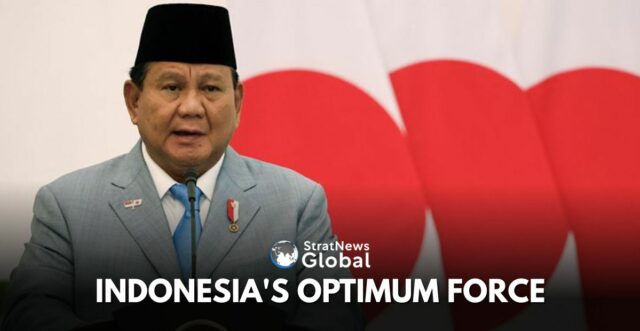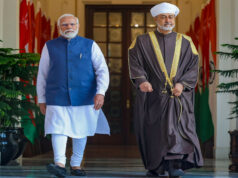Indonesia’s Defence Minister Sjafrie Sjamsoeddin has just wound up a visit to India that included talks with his counterpart Rajnath Singh in Delhi. An Indian Defence Ministry release said the talks covered the Indo-Pacific, India’s Indo-Pacific Oceans Initiative, cyber resilience and joint operational readiness.
The release said “Indonesia appreciated India’s proposal to establish a Joint Defence Industry Cooperation Committee to further strengthen collaboration in areas such as technology transfer, joint R&D, certification harmonisation, and supply-chain linkages.”
There was no reference to Indonesia wanting to buy the Brahmos missile that various media reports have alluded to. Although India has offered a line-of-credit, Jakarta is yet to make up its mind.
Other reports suggest a high level debate in that country about the pros and cons of buying Chinese military hardware. The military brass, it is said, may not be very keen on the idea although it is acknowledged that such hardware would come at affordable prices.
With that as the context, we bring you an exclusve Q&A with KHAIRUL FAHMI, Co-Founder Institute for Security & Strategic Studies in Jakarta
Q: The Indonesian military has a long history of being in power. How would you define its position today?
A: The Indonesian military (TNI) today has transformed into a professional, modern, and constitutionally disciplined defense institution. The reform era separated the military from politics, and since then, its focus has been on defense and national resilience, not governance.
However, Indonesia’s historical experience, where the military was deeply intertwined with the nation’s founding and survival, still shapes its ethos. The TNI remains a socially legitimate institution with strong public trust, often involved in humanitarian operations, disaster response, and community development.
Under President Prabowo, this role is being reframed: not as political involvement, but as functional proximity to the people, in line with the doctrine of Total People’s Defense.
Q: What does the Indonesian military see as its main challenges and where do these emanate from?
A: First, strategic uncertainty. Indonesia sits astride key sea lanes with proximity to the South China Sea, so any escalation among major powers reverberates across our waters. The mix of grey-zone tactics, ambiguous maritime claims, and rapid military modernization in the region creates a fluid risk environment that demands persistent presence and credible deterrence—especially around Natuna and critical chokepoints like Malacca, Sunda, and Lombok.
Second, non-traditional threats. Hybrid risks are rising: cyber intrusions on critical infrastructure, disinformation targeting social cohesion, terrorism with evolving tactics, illegal fishing and transnational crime, plus frequent natural disasters that require rapid military support. Resource competition, from energy to undersea minerals, adds pressure on maritime domain awareness and law-enforcement at sea, blurring lines between defense and security.
Third, internal readiness. Archipelagic geography magnifies logistics and sustainment challenges: moving people and kit across 17,000 islands, pre-positioning stocks, and maintaining high availability of platforms. Priorities include strengthening air/sea lift, joint C4ISR, interoperable communications, and lifecycle maintenance, alongside human capital, training, talent retention in cyber/tech fields, and faster decision loops across services and agencies.
These vectors demand a flexible, integrated defense system: joint operations by design, tighter civil-military coordination, resilient supply chains, and scalable responses from grey-zone to high-end contingencies. This is the logic behind Indonesia’s shift from Minimum to Optimum Essential Force, to anticipate, absorb, and deter across the full spectrum of threats.
Q: Does it have the capacity and capability to meet these challenges?
A: Indonesia’s defense capacity is still developing, but it is moving decisively toward modernization and integration. The TNI has strengthened its joint operational posture through the establishment of new territorial commands and specialized units in cyber, space, and information operations.
Technologically, the TNI is filling critical capability gaps, from maritime domain awareness to air mobility and strategic lift. The induction of platforms such as the A400M Atlas, new frigates and submarines, and long-range surveillance drones indicates a shift toward greater deterrence and regional presence.
While full capability parity with major powers is not the goal, Indonesia seeks to achieve credible deterrence, the ability to impose costs and defend its interests across domains, supported by a more agile command structure and stronger local defense industries.
Q: I understand under President Prabowo, military spending on modernization has got a boost. What can you tell us?
A: Yes, defense modernization under President Prabowo is gaining both momentum and strategic direction. Although Indonesia’s defense budget still hovers around 0.7-0.8 percent of GDP, there is a strong political commitment to raise it toward the psychological threshold of 1 percent of GDP. This target was part of President Prabowo’s 2024 campaign pledge and reflects a shift in mindset, from the old concept of Minimum Essential Force (MEF) to what he calls Optimum Essential Force (OEF).
The idea is to not just maintain the minimum operational level, but to build credible deterrence and readiness across all domains: land, sea, air, cyber, and space, while strengthening domestic industrial participation. The budget increase is expected to prioritize integrated procurement packages, infrastructure improvement, and technological independence, ensuring every dollar contributes to long-term resilience rather than short-term acquisition.
Q: From what I have read, it appears Indonesia is buying equipment and platforms from diverse vendors. There are questions about sustainability, relevance and how practical these procurements are.
A: Indonesia’s diversification is a deliberate strategic choice, not a procurement inconsistency. By working with multiple partners: France, South Korea, Turkey, the United States, and now India, Indonesia avoids dependence on any single supplier and gains access to various technologies and operational doctrines.
This approach also creates strategic leverage in diplomacy. For instance, partnerships with France (Rafale and Scorpène submarines), Turkey (KAAN fighter jets and missiles), and South Korea (KF-21 program and naval cooperation) allow Indonesia to blend technology transfer with strategic alignment.
The government recognizes that sustainability requires better interoperability and lifecycle planning. Thus, recent procurements are increasingly tied to long-term maintenance contracts, training, and domestic co-production, ensuring both practicality and technological learning.
Q: Apart from the Brahmos missile from India, what else do you think Indian industry can offer?
A: India and Indonesia share a civilizational connection and a strategic outlook rooted in autonomy and non-alignment. The proposed BrahMos sale is a milestone, but it should be viewed as the start of a broader defense industrial relationship.
India can offer cooperation in unmanned systems, radar and surveillance technology, electronic warfare, naval shipbuilding, and ammunition manufacturing. Moreover, India’s success with the Atmanirbhar Bharat (self-reliant defense industry) model offers valuable lessons for Indonesia’s own Make in Indonesia program.
Both countries are maritime democracies located at the crossroads of the Indo-Pacific, and their cooperation reflects a shared interest in stability, deterrence, and technological independence from major power blocs.
Q: What about Indonesia’s domestic defence industry?
Yes, “Make in Indonesia” is a cornerstone of President Prabowo’s vision for defense self-reliance. State-owned defense enterprises such as PT Pindad (land systems), PT PAL (shipbuilding), and PT Dirgantara Indonesia (aerospace) are undergoing transformation through joint ventures, co-production, and R&D partnerships.
Indonesia is already producing armored vehicles, small arms, guided rockets, and patrol vessels, and collaborating on advanced projects like the KF-21 fighter jet and medium-range missiles. The long-term target is for at least 50 percent of major platforms to be produced or maintained domestically within the next decade.
This industrial strengthening is also seen as a form of modern heroism, echoing the President’s belief that true independence today is achieved through the capacity to defend and sustain oneself technologically and economically.
Thirty eight years in journalism, widely travelled, history buff with a preference for Old Monk Rum. Current interest/focus spans China, Technology and Trade. Recent reads: Steven Colls Directorate S and Alexander Frater's Chasing the Monsoon. Netflix/Prime video junkie. Loves animal videos on Facebook. Reluctant tweeter.





